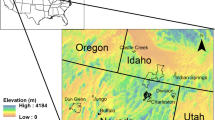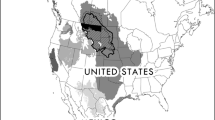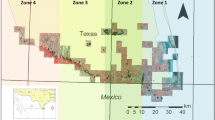Abstract
(1) We monitored post-fire shrubland recovery responses to changes in rainfall seasonality using a multi-year field experiment in the Cape Floristic Region (CFR) of South Africa. A primary objective was to test the utility of UAVs for monitoring ultra-fine-scale vegetation changes in the early post-fire context. (2) By comparison with detailed ground-based measurements, we showed that UAVs improved detection of integrated community growth responses, given that the appropriate relative radiometric normalisation techniques were applied to repeated imagery data. UAVs supported ground-based findings and, moreover, helped to identify previously undetected growth form responses. However, due to the limitations in detecting species-specific demographic changes, UAVs could not completely replace ground-based measurements. (3) Our combined UAV-based and ground-based monitoring approaches indicated strong coupling between post-fire shrubland recovery and seasonal rainfall patterns in the CFR but also demonstrated that sensitivity to rainfall seasonality could differ between neighbouring shrubland communities occurring on different soil types. (4) The careful integration of UAV-based and ground-based monitoring approaches provided the fullest understanding of early post-fire shrubland recovery patterns.









Similar content being viewed by others
Data availability
The data used during the current study are available from the corresponding author on reasonable request.
References
Altwegg R, West A, Gillson L, Midgley GF (2014) Impacts of climate change in the Greater Cape Floristic Region. In: Allsopp N, Colville F, Verboom GA (eds) Fynbos: ecology, evolution, and conservation of a megadiverse region. Oxford University Press, New York, pp 299–320
Anderson K, Gaston KJ (2013) Lightweight unmanned aerial vehicles will revolutionize spatial ecology. Front Ecol Environ 11:138–146
Aplin P (2005) Remote sensing: ecology. Prog Phys Geogr 29(1):104–113
Baena S, Moat J, Whaley O, Boyd DS (2017) Identifying species from the air: UAVs and the very high resolution challenge for plant conservation. PLoS ONE 12:e0188714
Bao N, Lechner AM, Fletcher A, Mulligan D, Mellor A, Bai Z (2012) Comparison of relative radiometric normalization methods using pseudo-invariant features for change detection studies in rural and urban landscapes. J Appl Remote Sens 6:063578
Bergh NG, Verboom GA, Rouget M, Cowling RM (2014) Vegetation types of the greater cape floristic region. In: Allsopp N, Colville JF, Verboom GA (eds) Fynbos: ecology, evolution, and conservation of a megadiverse region. Oxford University Press, Oxford, pp 1–26
Bond WJ, Van Wilgen BW (2012) Fire and plants, vol 14. Springer, New York
Bradshaw PL, Cowling RM (2014) Landscapes, rock types, and climate of the Greater Cape Floristic Region. In: Allsopp N, Colville JF, Verboom GA (eds) Fynbos: ecology, evolution, and conservation of a megadiverse region. Oxford University Press, Oxford, pp 26–46
Buters TM, Bateman PW, Robinson T, Belton D, Dixon KW, Cross AT (2019) Methodological ambiguity and inconsistency constrain unmanned aerial vehicles as a silver bullet for monitoring ecological restoration. Remote Sens 11:1180
Cunliffe AM, Brazier RE, Anderson K (2016) Ultra-fine grain landscape-scale quantification of dryland vegetation structure with drone-acquired structure-from-motion photogrammetry. Remote Sens Environ 183:129–143
Du Y, Teillet PM, Cihlar J (2002) Radiometric normalization of multitemporal high-resolution satellite images with quality control for land cover change detection. Remote Sens Environ 82:123–134
Duffy JP, Cunliffe AM, DeBell L, Sandbrook C, Wich SA, Shutler JD, Myers-Smith IH, Varela MR, Anderson K (2018) Location, location, location: considerations when using lightweight drones in challenging environments. Remote Sens Ecol Conserv 4:7–19
Fernández-Guisuraga JM, Calvo L, Suárez-Seoane S (2022) Monitoring post-fire neighborhood competition effects on pine saplings under different environmental conditions by means of UAV multispectral data and structure-from-motion photogrammetry. J Environ Manage 305:114373
Ghazal M, Al Khalil Y, Hajjdiab H (2015) UAV-based remote sensing for vegetation cover estimation using NDVI imagery and level sets method. In 2015 IEEE international symposium on signal processing and information technology (ISSPIT), IEEE, pp 332–337
Gitas I, Mitri G, Veraverbeke S, Polychronaki A (2012) Advances in remote sensing of post-fire vegetation recovery monitoring—a review. Remote Sens Biomass-Princ Appl 1:334
Grime JP et al (2000) The response of two contrasting limestone grasslands to simulated climate change. Science 289:762–765
Hall FG, Strebel DE, Nickeson JE, Goetz SJ (1991) Radiometric rectification: toward a common radiometric response among multidate, multisensor images. Remote Sens Environ 35:11–27
Han X, Thomasson JA, Xiang Y, Gharakhani H, Yadav PK, Rooney WL (2019) Multifunctional ground control points with a wireless network for communication with a UAV. Sensors 19:2852
Keeley JE (2012) Fire in Mediterranean climate ecosystems—a comparative overview. Israel J Ecol Evol 58:123–135
Keeley JE, Fotheringham CJ, Baer-Keeley M (2005) Factors affecting plant diversity during post-fire recovery and succession of mediterranean-climate shrublands in California, USA. Divers Distrib 11:525–537
Kröel-Dulay G, Ransijn J, Schmidt IK, Beier C, De Angelis P, De Dato G, Penuelas J (2015) Increased sensitivity to climate change in disturbed ecosystems. Nat Commun 6:1–7
Malek S, Bazi Y, Alajlan N, AlHichri H, Melgani F (2014) Efficient framework for palm tree detection in UAV images. IEEE J Select Top Appl Earth Observ Remote Sens 7:4692–4703
Mathews A, Jensen J (2013) Visualizing and quantifying vineyard canopy LAI using an unmanned aerial vehicle (UAV) collected high density structure from motion point cloud. Remote Sens 5:2164–2183
Moreno JM, Zuazua E, Pérez B, Luna B, Velasco A, Resco de Dios V (2011) Rainfall patterns after fire differentially affect the recruitment of three Mediterranean shrubs. Biogeosciences 8:3721–3732
Mucina L, Rutherford MC (2006) The vegetation of South Africa, Lesotho and Swaziland. South African National Biodiversity Institute
Nagai S, Nasahara KN, Akitsu TK, Saitoh TM, Muraoka H (2020) Importance of the collection of abundant ground-truth data for accurate detection of spatial and temporal variability of vegetation by satellite remote sensing. Biogeochem Cycles 1:223–244
Nelson ZJ, Weisberg PJ, Kitchen SG (2013) Influence of climate and environment on post-fire recovery of mountain big sagebrush. Int J Wildl Fire 23:131–142
Odum P (1969) The strategy of ecosystem development. Science 164:262–270
Otsu N (1979) A threshold selection method from gray-level histograms. IEEE Trans Syst Man Cybern 9:62–66
Pádua L, Guimarães N, Adão T, Sousa A, Peres E, Sousa JJ (2020) Effectiveness of sentinel-2 in multi-temporal post-fire monitoring when compared with UAV imagery. ISPRS Int J Geo Inf 9:225
Pajares G (2015) Overview and current status of remote sensing applications based on unmanned aerial vehicles (UAVs). Photogramm Eng Remote Sens 81:281–330
QGIS Development Team (2009) QGIS geographic information system. Open source geospatial foundation. http://qgis.org
Rasmussen J, Ntakos G, Nielsen J, Svensgaard J, Poulsen RN, Christensen S (2016) Are vegetation indices derived from consumer-grade cameras mounted on UAVs sufficiently reliable for assessing experimental plots? Eur J Agron 74:75–92
Rutherford MC, Powrie LW, Husted LB, Turner RC (2011) Early post-fire plant succession in Peninsula Sandstone Fynbos: the first three years after disturbance. S Afr J Bot 77:665–674
Sankey TT, McVay J, Swetnam TL, McClaran MP, Heilman P, Nichols M (2018) UAV hyperspectral and lidar data and their fusion for arid and semi-arid land vegetation monitoring. Remote Sens Ecol Conserv 4:20–33
Teillet PM (1986) Image correction for radiometric effects in remote sensing. Int J Remote Sens 7:1637–1651
Tucker CJ (1979) Red and photographic infrared linear combinations for monitoring vegetation. Remote Sens Environ 8:127–150
van Blerk JJ, West AG, Altwegg R, Hoffman MT (2021a) Does a trade-off between growth plasticity and resource conservatism mediate post-fire shrubland responses to rainfall seasonality? New Phytol 230:1407–1420
van Blerk JJ, West AG, Altwegg R, Hoffman MT (2021b) Post-fire summer rainfall differentially affects reseeder and resprouter population recovery in fire-prone shrublands of South Africa. Sci Total Environ 788:147699
Veraverbeke S, Gitas I, Katagis T, Polychronaki A, Somers B, Goossens R (2012) Assessing post-fire vegetation recovery using red–near infrared vegetation indices: accounting for background and vegetation variability. ISPRS J Photogramm Remote Sens 68:28–39
Waite CE, van der Heijden GM, Field R, Boyd DS (2019) A view from above: unmanned aerial vehicles (UAV s) provide a new tool for assessing liana infestation in tropical forest canopies. J Appl Ecol 56:902–912
West AG, Dawson TE, February EC, Midgley GF, Bond WJ, Aston TL (2012) Diverse functional responses to drought in a Mediterranean-type shrubland in South Africa. New Phytol 195:396–407
Wilson AM, Latimer AM, Silander JA Jr (2015) Climatic controls on ecosystem resilience: postfire regeneration in the Cape Floristic Region of South Africa. Proc Natl Acad Sci USA 112:9058–9063
Zhou Q (1996) Ground truthing, how reliable is it. In: Proceedings of Geoinformatics’ 96 Conference, West Palm Beach, FL pp 26–28
Zhou H, Liu S, He J, Wen Q, Song L, Ma Y (2016) A new model for the automatic relative radiometric normalization of multiple images with pseudo-invariant features. Int J Remote Sens 37:4554–4573
Acknowledgements
Funding was generously provided by the NRF (93380 to AGW and 119125 to RA) and ACCESS groups (114696). Thank you to the Plant Conservation Unit for their contribution to the establishment of the Drie Kuilen rainfall manipulation experiment. JJvB was supported by a UCT Science Faculty Scholarship. We are grateful to the NCC and the Drie Kuilen Nature Reserve for providing access and support. Thank you to the many field assistants who were eager to help throughout the research process.
Funding
Funding was provided by National Research Foundation (Grant Nos. 93380, 119125), National Research Foundation (ACCESS) (Grant No. 114696).
Author information
Authors and Affiliations
Contributions
JJvB, AGW, MTH, RA and JS conceptualized the research. JJvB, MTH and AGW collected the data. JJvB processed the data and wrote the manuscript, with contributions from AGW, MTH, RA and JS.
Corresponding author
Ethics declarations
Conflict of interest
The authors have no relevant financial or non-financial interests to disclose.
Additional information
Publisher's Note
Springer Nature remains neutral with regard to jurisdictional claims in published maps and institutional affiliations.
Supplementary Information
Below is the link to the electronic supplementary material.
Rights and permissions
Springer Nature or its licensor holds exclusive rights to this article under a publishing agreement with the author(s) or other rightsholder(s); author self-archiving of the accepted manuscript version of this article is solely governed by the terms of such publishing agreement and applicable law.
About this article
Cite this article
van Blerk, J.J., West, A.G., Smit, J. et al. UAVs improve detection of seasonal growth responses during post-fire shrubland recovery. Landsc Ecol 37, 3179–3199 (2022). https://doi.org/10.1007/s10980-022-01535-4
Received:
Accepted:
Published:
Issue Date:
DOI: https://doi.org/10.1007/s10980-022-01535-4




